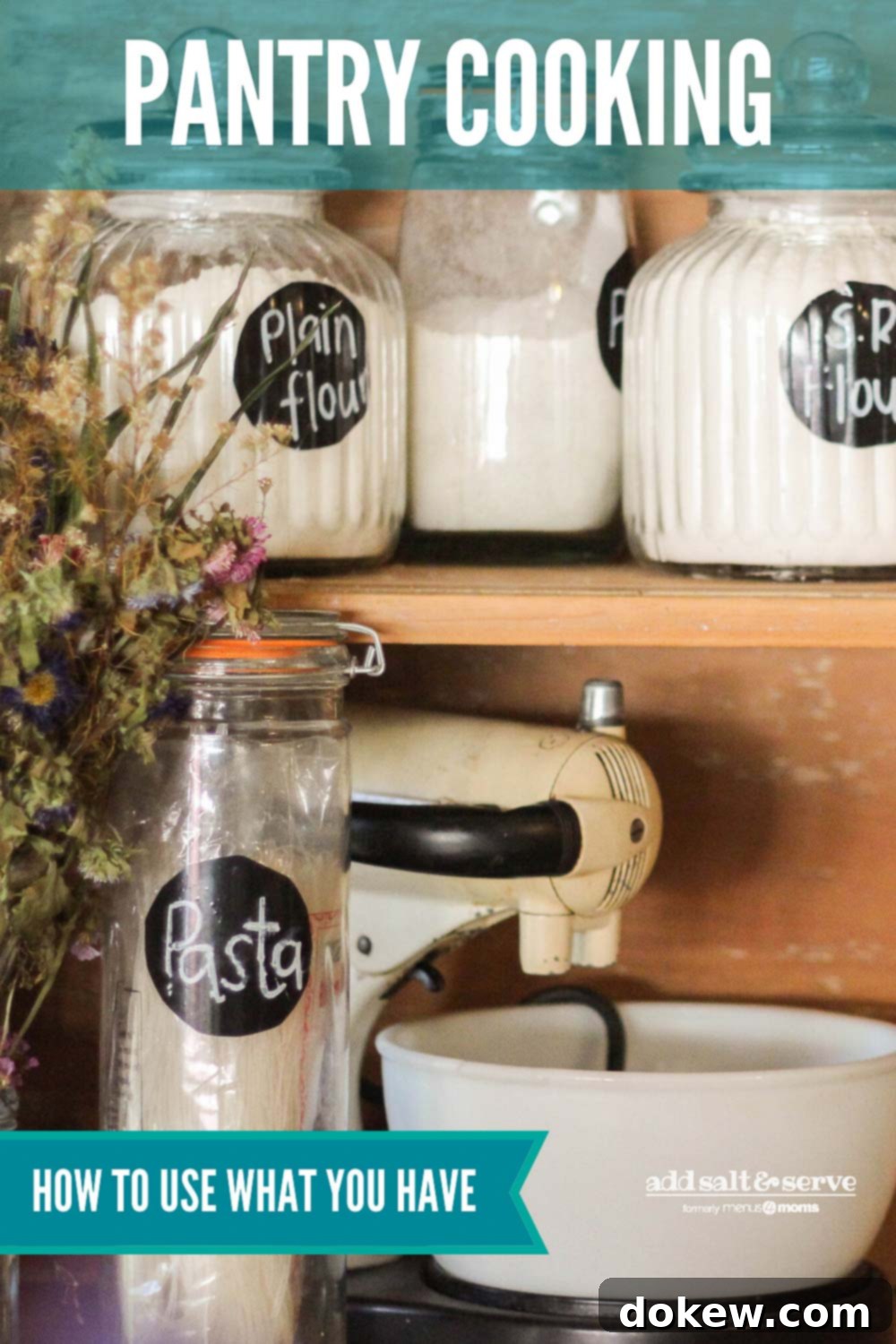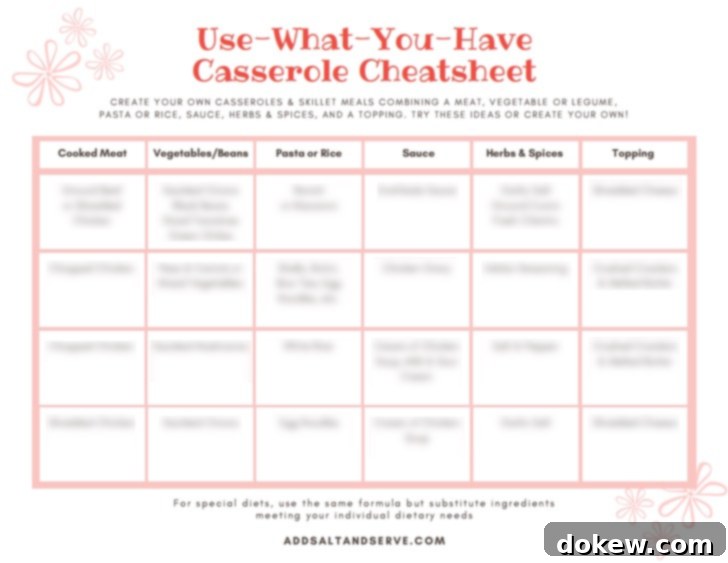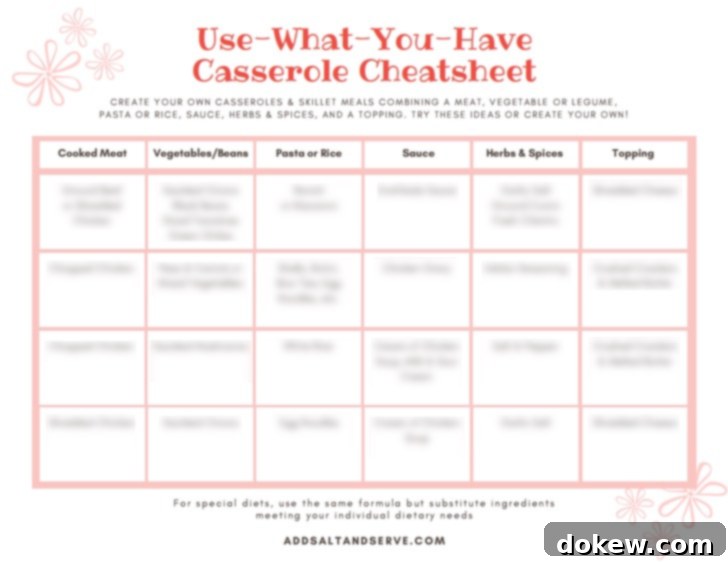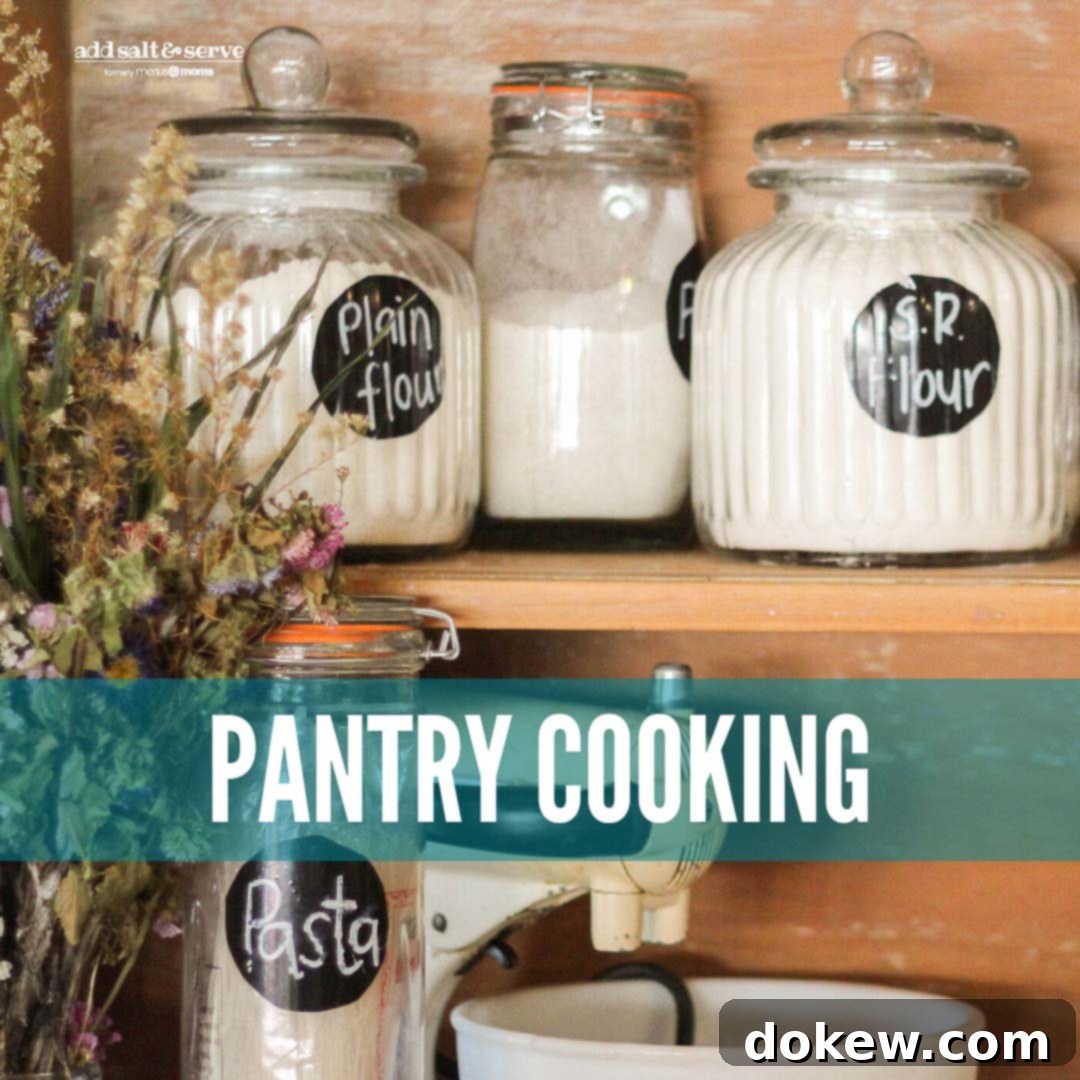Pantry Power: Effortless & Delicious Meals Using What You Already Have
Are you tired of staring into your pantry, feeling overwhelmed by ingredients but still not knowing what to cook? Do you find yourself searching for “easy recipes” only to discover you lack a key ingredient? It’s a common dilemma, but one with a simple solution: master the art of pantry cooking. This approach focuses on utilizing the ingredients you already have on hand, transforming them into satisfying and delicious meals without the stress of last-minute grocery runs or complex substitutions. Even if you’re new to creative cooking, these basic formulas and adaptable ideas will empower you to create culinary magic from your existing staples.
Pantry cooking isn’t just about convenience; it’s a smart, sustainable, and budget-friendly way to eat. By reducing food waste and maximizing the shelf life of your ingredients, you’ll save money and contribute to a more mindful kitchen. It encourages flexibility and creativity, turning cooking from a chore into an exciting challenge. Get ready to unlock the full potential of your pantry and refrigerator with these versatile meal concepts.

To kickstart your pantry cooking journey, download our exclusive cheatsheet printable. It’s packed with inspiring ideas and practical tips for making the most of your current inventory!

Eggs: The Versatile Pantry Staple
Eggs are a true culinary chameleon, capable of transforming into a satisfying meal with minimal effort and a few additional ingredients. Their protein-rich nature makes them an ideal base for breakfast, lunch, or dinner, and they pair wonderfully with an array of vegetables, cheeses, and seasonings you likely already have. From elegant strata to quick quiches, eggs are your go-to for utilizing bits and bobs from your fridge.
- Strata. A strata is essentially a savory bread pudding, a fantastic way to use up stale bread and leftover cheese. Begin by layering cubes or slices of bread (stale is actually preferred as it absorbs the egg mixture better) and your choice of sliced or shredded cheese in a baking pan. For the custard, whisk together 4 eggs with about 2-⅔ cups of milk. Season generously with salt, black pepper, and a touch of dry mustard for a subtle tang that complements the cheese. Pour this creamy egg mixture over the bread and cheese, ensuring all the bread is moistened. Bake at 350ºF (175ºC) for approximately 45 minutes. Baking time may vary depending on the depth and dimensions of your pan, so look for a golden-brown top and a firm center when a knife is inserted. This dish is incredibly forgiving and can be customized with sautéed onions, cooked vegetables, or leftover cooked meat.
- Crustless Quiche. For a lighter, gluten-friendly option that’s just as delicious, a crustless quiche is perfect. In a large bowl, beat 8 eggs vigorously with one cup of milk, one cup of shredded cheese (cheddar, mozzarella, Swiss, or a mix work well), salt, and pepper. The beauty of this recipe lies in its adaptability: incorporate a 10 oz package of frozen vegetables that has been thawed, cooked, drained, and roughly chopped. Think broccoli, spinach, mixed vegetables, or even sautéed mushrooms. Pour the mixture into a pie plate or an oven-safe dish and bake at 350°F (175ºC) for about 40-50 minutes, or until the center is set and a knife inserted comes out clean. This makes for an excellent make-ahead meal that can be enjoyed warm or cold.
Casseroles: The Ultimate Comfort Food Creation
Casseroles are the quintessential “use what you have” meal, beloved for their comforting nature and incredible versatility. They allow you to combine various ingredients into a single, hearty dish that bakes to perfection, often yielding delicious leftovers. The beauty of a casserole lies in its flexible formula, enabling endless combinations based on what’s in your pantry and fridge. You can easily create a new culinary experience simply by swapping out a few key components.
To construct a successful casserole from scratch, consider these foundational elements:
- Cooked Meat: Leftover roasted chicken, browned ground beef, shredded pork, or even canned tuna or ham can form the protein base.
- Vegetables: Fresh, frozen, or canned vegetables all work well. Think peas, corn, green beans, carrots, broccoli, spinach, or sautéed onions and peppers.
- Cooked Pasta or Grains: Any shape of cooked pasta, rice, quinoa, or even leftover potatoes can serve as the carbohydrate filler, adding substance and texture.
- A Sauce: This is where much of the flavor comes from. Canned cream of mushroom/chicken soup, pasta sauce, gravy, cheese sauce, or even a simple homemade béchamel can bind everything together and add moisture.
- Herbs and Spices: Essential for elevating the flavor profile. Don’t be shy about adding your favorite seasonings to match your chosen cuisine style.
- A Topping: Adds a delightful crust and visual appeal. Options include shredded cheese, buttery bread crumbs, crushed crackers, French fried onions, or even crushed potato chips.
To create your casserole, simply mix all your chosen ingredients together (except the topping, which goes on last). Transfer the mixture to a baking dish, add your topping, and bake at 350ºF (175ºC) until it’s heated through, bubbly, and the topping is golden brown and crispy. The cooking time will depend on the temperature of your ingredients and the depth of the casserole, usually ranging from 25 to 40 minutes.
Here are some classic examples to inspire your own creations:
- Italian Pasta Bake. This family favorite is incredibly satisfying. Combine cooked ground beef (or Italian sausage), your favorite cooked pasta shape (penne, rotini, or spaghetti work well), finely diced and sautéed onions, and a rich marinara or pasta sauce. Pour the mixture into a baking pan. For a classic finish, sprinkle generous bread crumbs on top and dot with small pats of butter for extra crispiness. Bake at 350ºF (175ºC) for about 25 minutes, or until the casserole is bubbling hot and the topping is lightly browned and inviting. Serve with a side salad for a complete meal.
- Mexican Pasta Bake. Infuse your casserole with vibrant Southwestern flavors. Mix tender cubed cooked chicken with cooked pasta (elbow macaroni or small shells are great here), drained canned green chilies, diced tomatoes (fresh or canned), and sautéed onions. The key flavor component is a can of red enchilada sauce, which brings everything together. Pour this colorful mixture into a baking pan. Top generously with shredded Monterey Jack or cheddar cheese, and bake at 350ºF (175ºC) for 30 minutes, or until the cheese is melted and bubbly. A sprinkle of fresh cilantro after baking adds a final flourish.
Stovetop Meals: Quick & Customizable Dinners
When you need a meal in a hurry, stovetop dishes are your best friend. They follow a similar customizable philosophy as casseroles but offer the advantage of faster cooking times, perfect for busy weeknights. The same core components – cooked meat, vegetables, cooked pasta/grains, and a flavorful sauce – can be combined in a skillet or pot on the stovetop to create an endless array of delicious and hearty meals. This method minimizes oven use and can often be whipped up in under 30 minutes.
The beauty of stovetop meals is their ability to transform leftovers and pantry staples into something fresh and exciting. Start by sautéing aromatics like onions or garlic, then add your protein, vegetables, and pre-cooked pasta or grain. Stir in your chosen sauce and let it simmer until everything is heated through and the flavors have melded. Adjust seasonings as needed, and you have a quick, satisfying meal ready to serve.
Here are a couple of examples to get your creative juices flowing:
- Mediterranean Stovetop Meal. Bring the flavors of the Mediterranean to your kitchen. Combine tender cooked chicken (rotisserie chicken works wonderfully), al dente cooked pasta, and a medley of Mediterranean vegetables such as sliced black olives, sun-dried or diced tomatoes, and roasted red peppers. For an authentic touch, add a splash of good quality Balsamic vinegar and a drizzle of olive oil, then heat gently until warmed through. Serve this vibrant dish topped with crumbled feta cheese, shredded mozzarella, or grated Parmesan for a salty finish. A sprinkle of fresh basil or oregano would be a perfect addition.
- Mexican Ravioli. This dish offers a playful twist on traditional Mexican flavors using a convenient pantry item. Combine cooked beef ravioli with a can of zesty red enchilada sauce, a cup of your favorite salsa (mild or spicy), and a can of sliced black olives. Heat everything together in a large skillet until simmering and well combined. Before serving, stir in or top with a generous amount of shredded cheese like cheddar or Monterey Jack, allowing it to melt into a gooey, flavorful sauce. This quick and comforting meal is packed with savory goodness and can be on your table in minutes.
Soups: The Ultimate Leftover Champion
If there’s one dish that truly champions the art of using what you have, it’s soup. Soups are incredibly forgiving, infinitely customizable, and the absolute best way to transform disparate leftovers and miscellaneous frozen vegetables into a cohesive, flavorful meal. Their adaptability means you can throw in almost any ingredients and adjust the flavors as they cook until you achieve perfection. This makes soup not just a meal, but a practical and delicious solution for minimizing food waste.
One ingenious strategy for pantry soup is to maintain a “freezer clean-out” container throughout the week. As you prep meals, add any small quantities of leftover cooked vegetables, pasta, or even bits of cooked meat to this container. By the end of the week, you’ll have a treasure trove of ingredients ready to be transformed. Paired with any meat you have in the refrigerator and a good broth, this becomes the foundation for a magnificent pot of “end of the week” soup.
End of the Week Soup: A Step-by-Step Guide.
Start by sautéing aromatic vegetables like chopped onions, garlic, or leeks in a large pot with a drizzle of oil until fragrant and softened. This builds a foundational layer of flavor. Next, add a high-quality broth – choose chicken, beef, or vegetable broth to complement your main protein, or use vegetable broth for a universally appealing base. Incorporate your cooked meat (from the fridge or freezer) and all those “freezer clean-out” vegetables. Add your favorite herbs and spices; bay leaves, thyme, oregano, and a pinch of red pepper flakes can all contribute depth. Bring the mixture to a boil, then reduce the heat and let it simmer gently until all the ingredients are tender and the flavors have fully melded. Taste and adjust seasonings as necessary. For best results, cook any pasta separately and add it to individual bowls just before serving. This prevents the pasta from becoming mushy and absorbing all the delicious broth, ensuring a pleasant texture and maximum flavor with every spoonful. Store leftover soup and pasta separately to maintain quality.
Salads: Fresh, Light, and Limitless Combinations
When the weather warms up or you simply crave something lighter, chilled pasta or rice salads are an excellent way to use up ingredients on hand. Like casseroles, they are built on a similar adaptable framework but swap rich sauces for vibrant salad dressings. This makes them perfect for meal prep, picnics, or a refreshing side dish that can easily be scaled up to a main course with added protein.
The key to a successful “use what you have” salad is thinking in terms of cuisine categories. By grouping ingredients and dressings that traditionally go together, you can create a harmonious and delicious flavor profile without needing a precise recipe. Consider your base – cooked pasta (any shape), rice, quinoa, lentils, or even farro – then add a mix of vegetables, proteins, and a dressing that ties it all together.
For vegetables, almost anything goes: chopped bell peppers, cucumbers, cherry tomatoes, shredded carrots, celery, red onion, corn, or blanched green beans. For protein, think canned chickpeas, black beans, cooked chicken, tuna, hard-boiled eggs, or crumbled feta. The dressing is crucial for bringing the chosen cuisine category to life.
Consider these dressing choices to guide your ingredient pairings:
- Italian. Pair with an zesty Italian vinaigrette or a tangy balsamic dressing. Think sun-dried tomatoes, olives, mozzarella, and cured meats.
- Mexican. Opt for a creamy ranch dressing, a zesty lime vinaigrette, or a French dressing with a hint of sweetness. Corn, black beans, avocado, bell peppers, and grilled chicken or ground beef would be excellent additions.
- Mediterranean. A vibrant Greek dressing, a refreshing tzatziki sauce, or a robust blue cheese dressing will perfectly complement ingredients like cucumbers, tomatoes, bell peppers, olives, feta cheese, and grilled lamb or chicken.
- Asian. A savory sesame-ginger dressing or a peanut sauce will bring out the best in ingredients like shredded cabbage, carrots, edamame, bell peppers, grilled chicken, or shrimp.
Help with Herbs & Spices: Mastering Flavor Combinations
The right combination of herbs and spices can elevate a simple pantry meal from ordinary to extraordinary. When you’re deciding which seasonings to use, draw inspiration from your family’s favorite recipes. If they love Italian food, lean into flavors like oregano, basil, garlic powder, and a hint of red pepper flakes. For a Mexican-inspired dish, consider cumin, chili powder, coriander, and smoked paprika. Building a well-stocked spice rack is an investment that pays dividends in flavor and flexibility.
To further enhance your culinary confidence, you may wish to invest in the digital version of The Flavor Bible (affiliate link). This invaluable resource acts as a chef’s secret weapon, offering extensive lists of ingredient pairings and, crucially, suggestions for complementary herbs and spices. If you have a specific ingredient you want to use but are unsure how to flavor it, this book provides incredible guidance, making experimental cooking less daunting and more delicious. It’s a fantastic tool for any aspiring pantry chef.
Remember, tasting as you go is key. Start with smaller amounts of spices and gradually add more until you reach your desired flavor intensity. Don’t be afraid to experiment; sometimes the most unexpected combinations yield the most delightful results. A well-seasoned dish is always more satisfying, and herbs and spices are the heart of flavor creation.
Download our exclusive cheatsheet printable with even more ideas for using what you have – it’s your go-to guide for transforming pantry staples!

Pantry cooking is a journey of discovery, creativity, and sustainability. By embracing these simple formulas and flexible approaches, you’ll not only reduce food waste and save money but also become a more confident and resourceful cook. We’d love to hear about your culinary adventures! Have you come up with any great recipes using this method of cooking? Share your creations and tips in the comments below.
More Versatile Recipes To Use What’s On Hand
Ready for more inspiration? Explore these additional recipes designed with pantry staples and flexibility in mind. Each one offers a delicious way to utilize ingredients you likely already possess, minimizing waste and maximizing flavor.
- Quick & Easy Mexican Style Soup
- One Pot Tomato Spinach Pasta
- Cheesy Tuna Casserole
- Chicken Fried Rice
See more like this
